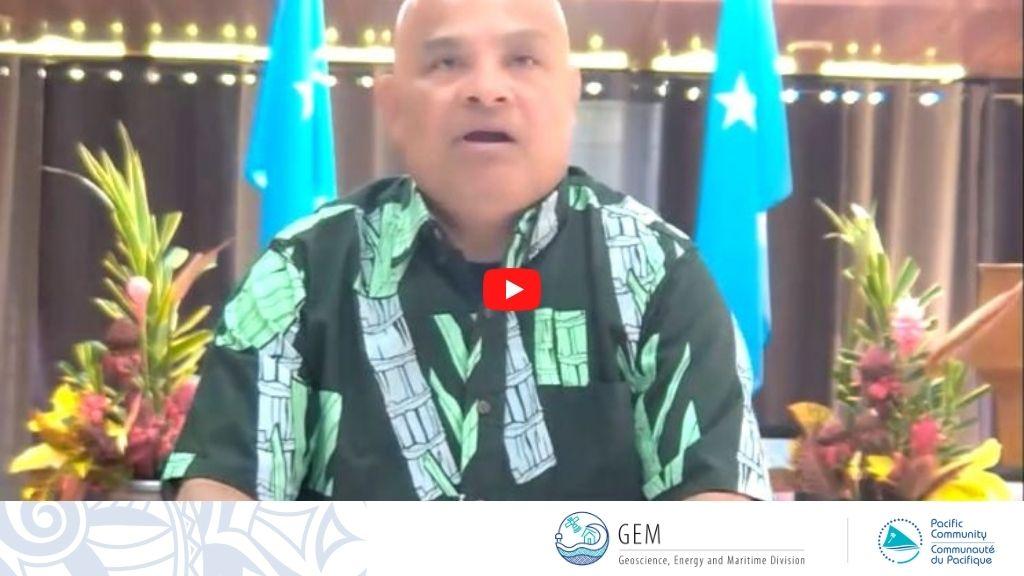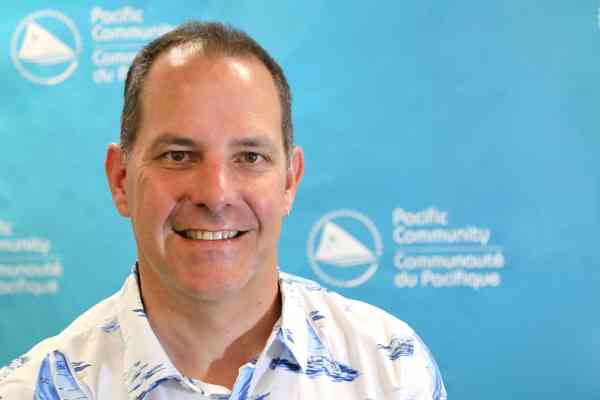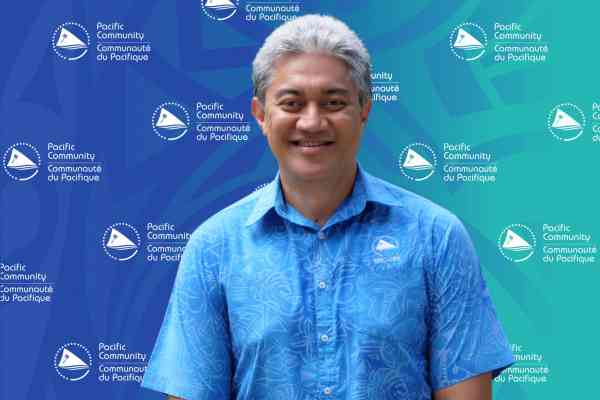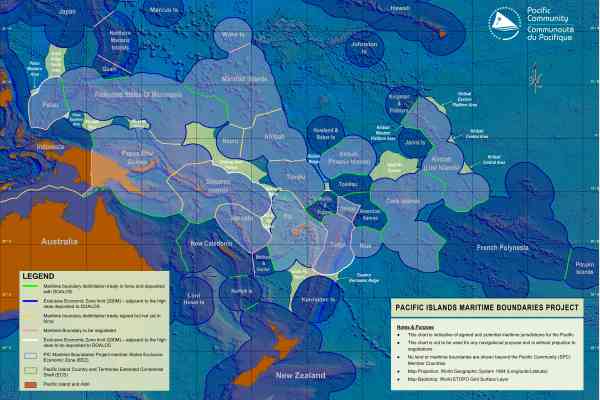Excellencies, Distinguished Leaders in the Pacific, Ladies and Gentlemen.
Allow me at first to convey my personal appreciation to the Director General of the Pacific Community, Dr Stuart Minchin, for inviting me to address this High-Level Dialogue. I am very pleased and honoured with this invitation knowing that Micronesia’s important progress and practical experiences in the process of securing our maritime boundaries are informative to the Pacific. There is no question about the urgency of concluding our Maritime Boundaries in light of the overwhelming threats posed by climate change and the devastating impacts upon our fragile island environment. Securing the survival of the Blue Continent for our children and the future generation of the Pacific people is our mission.
I also take this opportunity to acknowledge the remarks made by the Pacific Ocean Commissioner, Hon. Henry Puna, and the Director General of the Forum Fisheries Agency, Dr Manu Tupou-Roosen, and all the distinguished and honoured guests present at this High-Level virtual Dialogue.
Excellencies: As a large Ocean State of highly dispersed islands, many of which are low-lying, it is a fact that like many other island nations in the Pacific and around the world, the Federated States of Micronesia is grappling with the devastating adverse effects of sea-level rise. Yet, the irony is that, FSM contributed very little to overall global greenhouse gas emissions, just like many other Ocean countries in the Pacific.
The FSM is home to some of the richest biodiversity in the world, including extremely rich fisheries resources. Our duty is to protect our Ocean resources being the backbone of our livelihood, economic development and environmental stability.
The famous Challenger Deep in the Mariana’s Trench is located in our exclusive economic zone. Another world-leading depth of approximately 8,946 meters below sea level—officially named as the Yap World’s Deep—is located in the territorial sea along the Yap Trench.
With rich Ocean resources, highly dispersed and low-lying islands, just like everyone in this forum, the FSM is facing the overwhelming challenges associated with sea-level rise. Maritime security and the stability of our maritime borders are critical. Hence, our ultimate goal is to secure our maritime borders and to maintain the stability, security, certainty, and predictability of our maritime zones, along with the preservation of the rights and entitlements that flow from those maritime zones according to the United Nations Convention on the Law of the Sea (“UNCLOS”).
A fully delineated maritime boundary means not only certainty and security; it also means that potential disputes with neighbouring countries are reduced.
We have completed the negotiation of our maritime boundaries, concluded them and ratified all such delimitation treaties.
The FSM also promulgated a national regulation that sets out all the official coordinates of our baselines, territorial waters, and exclusive economic zone. We incorporated in the regulation the boundary delimitation lines that we negotiated with the United States, the Republic of Palau, the Independent State of Papua New Guinea and the Republic of Marshall Islands.
We also REGISTERED and deposited our OFFICIAL baselines and complete information on the outer limits of our maritime zones —including the legislation and regulation for those baselines and zones—as well as all our maritime boundary delimitation treaties with the UN Secretariat via UN DOALOS and the United Nations Treaty Section in New York, making them official and internationally recognized.
In our deposit of maritime zone information with the UN Secretary-General via UN DOALOS, we also provided a set of Accompanying Observations addressing our views with respect to the relationship between sea-level rise and our maritime zones. The FSM informed the UN Secretary-General—and in effect, the whole world given that this official deposit is accorded global publicity—that the FSM’s view is that it is not obliged to keep under review the maritime zones reflected in the present official deposit notwithstanding climate change-induced sea-level rise.
All these efforts so far produced positive results because of the commitment and dedication of our national team, the SPC and its consortium partners, Geoscience Australia, Australian Attorney General’s Department, FFA, GRID-Arendal, Commonwealth Secretariat, and the University of Sydney that had been providing technical and legal support since 2002. Very importantly, the collective foresightedness of the Leaders involved agreeing in principle to collaborate the island way and in good faith paved the way for the successful conclusion of our maritime boundary delimitation treaties without the need for any complicated negotiations. This approach served us well and reminded us of the continued importance and relevance of the traditional relationship between the islands and our shared steward of the oceans.
We continue to work on the extended continental shelf projects, and seek the continued support of SPC and the consortium partners.
I also take this opportunity to recognize and to commend the Pacific Leaders for our collective Declaration on Preserving Maritime Zones in the face of Climate Change-related Sea-level rise, which the Leaders of the Pacific Islands Forum endorsed in August this year and which was later reaffirmed by the Micronesian Presidents’ Summit. As we expressed ourselves in solidarity with each other our collective views in that Declaration on Preserving Maritime Zones in the Face of Climate Change-related Sea-Level Rise, it is my hope that the landmark normative declaration will serve its purpose of clarifying our interpretation as a region of the relevant international law pertaining to the relationship between climate change-related sea-level rise and maritime zones, as supported by UNCLOS and the legal principles underpinning it.
Excellencies: In addition to our maritime boundary projects, FSM also invested in several extended continental shelf (“ECS”) projects with respect to the surrounding high seas pockets, which could extend sovereign rights upon the seabed up to 350 nautical miles limit according to UNCLOS.
At the moment, there are four areas of our ECS Projects, three of which were already filed with the Commission on the Limits of the Continental Shelf. The joint submission for the Ontong Java Plateau with a total area of over 600,000 square kilometers is a collaboration between FSM, PNG and Solomon Islands. This is the first Joint ECS Submission in the Pacific that the Commission has recommended so far. The examination process took place from 2014 up to 2017—with 14 weeks of meetings of the subcommission, 13 meetings and consultation with the 3 submitting states, 9 presentations by the submitting delegations, and 8 presentations by the subcommission in the course of the examination.
Another extended continental shelf area of FSM is the Eauripik Rise (approximately 175,000 square kilometers), which was lodged with the Commission in 2013. This submission is awaiting the establishment of a sub-commission to examine it. Indonesia and PNG are interested in this same area as well.
Another area of interest to FSM is the Mussau Ridge (approx. 14,000 square kilometers), which is a subject of a preliminary information presentation—requiring further work and acquisition of supporting data.
Recently, we have completed the Main Body for another ECS Submission for the North of Yap Area. We consulted with Palau and Japan, and we will lodge this submission with the Commission very soon.
Excellencies: It is clear from our national experiences that we need to keep our national law updated with these recent developments that I have just described. FSM must be prepared to domesticate its assertion of sovereign rights through legislation covering: 1. sovereign rights over the exploration and exploitation of natural resources, 2. exclusive rights to authorize and regulate drilling on the continental shelf for all purposes, 3. exclusive rights to construct, authorize and regulate the construction, operation and use of artificial islands, installations and structures, 4. jurisdiction with respect to protection and preservation of the marine environment, and 5. the right to regulate, authorize and conduct marine scientific research.
We will continue to make progress in our Maritime Boundaries, and we are willing to share our experiences and best practices to our brothers and sisters in the Pacific Region anytime.
In closing, I wish to leave you with this message: the future of the Pacific is full of difficult challenges caused by many factors, including Climate Change. Fortunately, the challenges themselves also present to us great opportunities for innovation. I am pleased to note our active involvement in the ongoing study by the International Law Commission in the area of sea-level rise in relation to international law, the BBNJ negotiations, and also our engagements with the important work of the Sixth Committee of the United Nations. We continue to pursue these important issues on the various international forums, including those that I mentioned. We owe it to future generations in our nation to preserve our fragile environment and resources in a nurturing condition that will also ensure their survival. What we do today will be our prosperity tomorrow.
Thank you.



